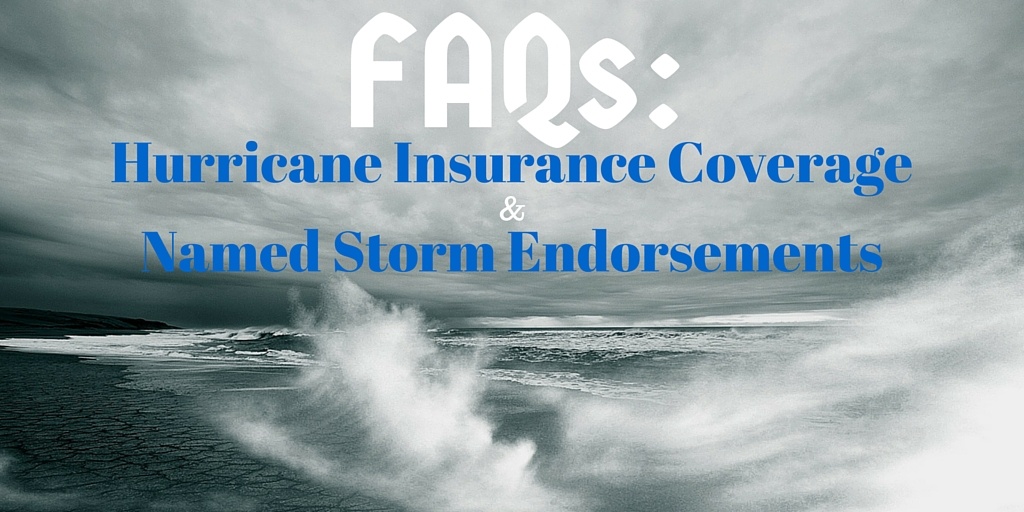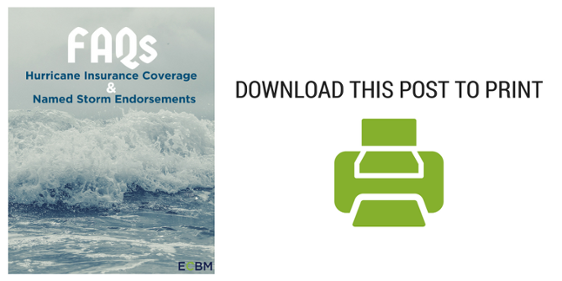
The Atlantic hurricane season has already been underway for a couple of months now, running officially from June 1 to November 30, 2015. The 2015 hurricane season is expected to be relatively tame, with various agencies projecting a below average season with 3 to 5 hurricanes, only 1 or 2 of which will qualify as major hurricanes.
Still, it’s never a bad time to review your property coverage’s named storm damage if you live along the Coast. Even Hurricane insurance coverage differs significantly from property insurance.
Does Homeowners Insurance Cover Hurricane Deductibles?
Hurricane and named storm deductibles were introduced as a way to shift more of the risk responsibility on the policyholder. By reducing payouts, the plan was to control insurance costs of those further from the danger zone. (More Here)
Deductibles for named storm damages are significantly increased. Where a person’s property coverage for their home may include a $500 deductible, named storm deductibles are typically expressed as a percentage of the home’s value. These percentages can range between 1% and 10%. Thus, a person with a $500,000 home and a 5% named storm deductible would have to pay the first $25,000 of damages caused by a named storm despite having a policy that would only call for a $500 deductible in normal circumstances.
What Is Named Storm Insurance?
When a number or “name” has been given to a weather even is called a hurricane, typhoon, tropical storm, or cyclone by the United States National Weather Service, the United States National Hurricane Center, or The United States National Oceanic and Atmosphere Administration. (Superstorm Sandy, Hurricane Irene, etc) Any loss that is caused by or results from the event would require this type of coverage. The events can occur at any time of the year.
Alabama, Connecticut, Delaware, The District of Columbia, Florida, Georgia, Hawaii, Louisiana, Maine, Maryland, Massachusetts, Mississippi, New Jersey, New York, North Carolina, Pennsylvania, Rhode Island, South Carolina, Texas, and Virginia all have some form of hurricane or named storm endorsement deductible in place.
Also Read: WINDSTORM COVERAGE: IF YOU BELIEVE YOUR PROPERTY POLICY RESPONDS TO A HU
Named Storm vs Wind Deductible?
Hurricane coverage comes in three common forms: windstorm deductible, named storm deductible, and hurricane deductibles. Named Storm deductibles are the most common, with windstorm deductibles increasing the deductibles’ application and hurricane deductibles decreasing it.
Windstorm deductibles apply to tropical storms but can also cover winter nor’easters and other storms.
Named storm deductibles cover damage caused by named storms, including tropical storms.
Hurricane deductibles only apply to storms that qualify as at least Category 1 hurricanes when making landfall. (The exact difference in these triggers can vary depending on state law so property owners are advised to review their policies and consult with their agents.)
Named Storm Exclusion Confusion
Hurricane Sandy provides a good example of confusion in what coverage applies when.
- As Sandy made its way up the East Coast along the Atlantic seaboard, it was classified as a Category 1 hurricane.
- By the time Sandy made landfall, it had been downgraded to a tropical storm.
This meant that those who had a named storm deductible had to pay their named storm deductible whereas those who had a hurricane deductible only had to pay their normal deductible- This could be a difference of thousands of dollars in deductible payments for property owners! Of course this means that cases are being ruled on in courts along the coast as to which deductible should have been applied.
The difference between a $500 payout and a $25,000 payout can be massive both for a personal property owner or a business. Insureds should review their policy to ensure they have the coverage they need.
What you can do:
- Ask if windstorm or if a wind/hail deductible is outlined in your policy.
- Know what your deductibles are and adjust your limits if needed.
- Know the laws regarding named storms in your area Click Here For More Information
- Prepare your family, business, and home for storms Click Here For Tips
- Don’t forget about Flood Insurance!


